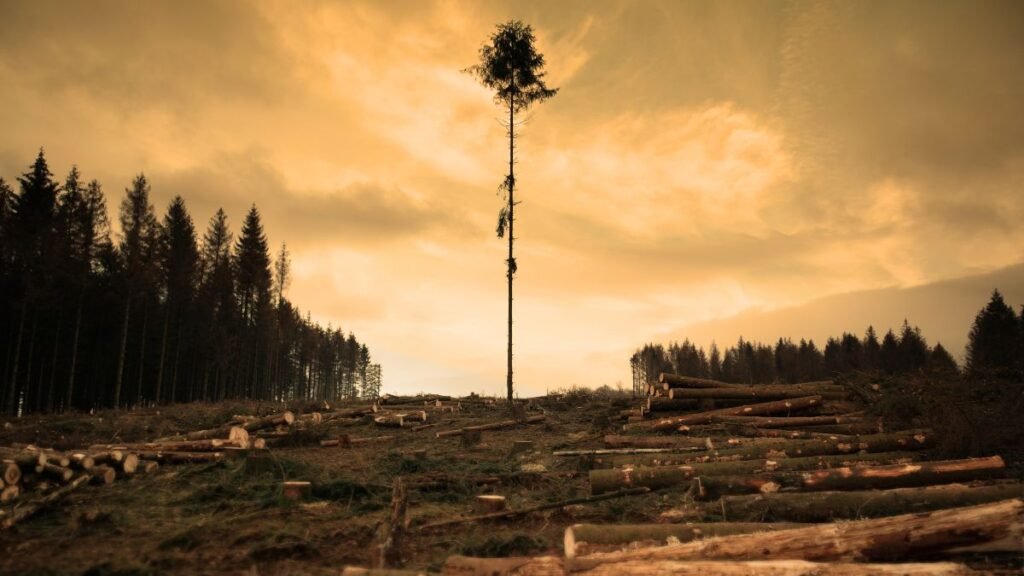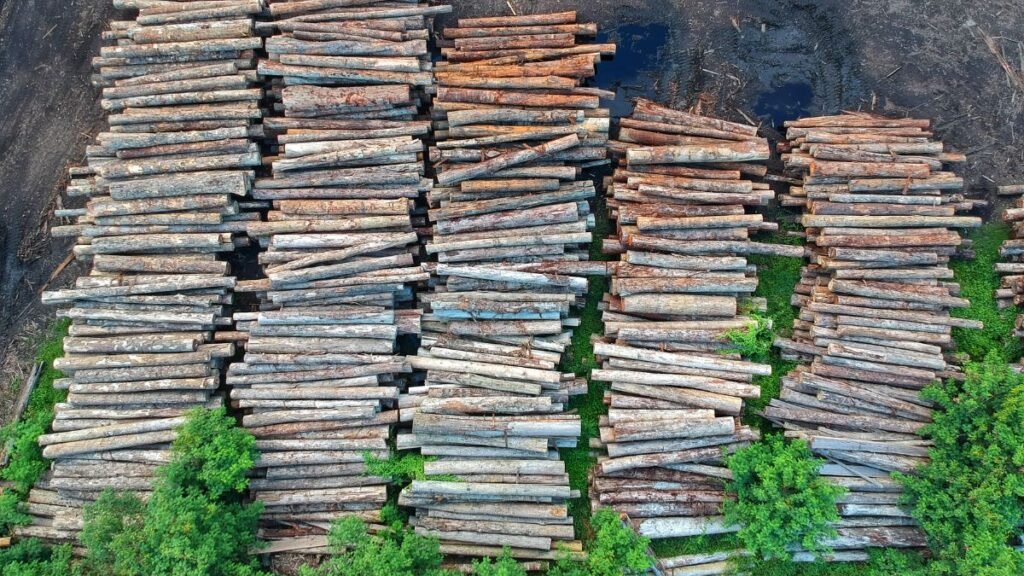Introduction
The Amazon rainforest, often referred to as the “lungs of the Earth,” has faced significant challenges over the years due to various human activities and environmental factors, particularly severe deforestation in Brazil. Since 2000, Brazil has lost 68.9 million hectares of tree cover, accounting for approximately 13% of its total forest area. This alarming loss has had a profoundly detrimental impact on biodiversity, carbon storage, and the global climate. It has led to a decrease in wildlife habitats and contributed to an increase in greenhouse gas emissions.
The Amazon rainforest, often referred to as the “lungs of the Earth,” has faced significant challenges over the years due to various human activities and environmental factors, particularly severe deforestation in Brazil. Since 2000, Brazil has lost 68.9 million hectares of tree cover, accounting for approximately 13% of its total forest area.
This alarming loss has profoundly impacted biodiversity, carbon storage, and the global climate, decreasing wildlife habitats and contributing to increased greenhouse gas emissions.
The Amazon plays a crucial role in regulating the Earth’s climate, and its degradation poses a serious threat to local ecosystems, global weather patterns, and climate stability.

This article examines seven innovative green projects that address the root causes of deforestation, including cattle ranching and illegal logging. These initiatives aim to protect the Amazon rainforest and address the economic and climate stakes. The journey to strike a balance between environmental preservation and economic growth is complex, but these projects offer hope for a sustainable future.
Key Takeaways
- Brazil has lost 68.9 million hectares of tree cover since 2000.
- Deforestation rates dropped by 50% in 2023, the lowest in five years.
- Cattle ranching and illegal logging are major drivers of deforestation.
- Green projects focus on economic and environmental sustainability.
The Current State of Deforestation in Brazil
Recent data reveals a mixed picture of deforestation trends in the Amazon. Since 1970, over 700,000 square kilometres of forests have been lost, with 43% of global deforestation occurring in this region as of 2022. This alarming trend has had a significant impact on biodiversity and carbon emissions worldwide.
The loss of such vast forest areas threatens countless species that rely on these ecosystems for survival and exacerbates climate change by releasing stored carbon dioxide into the atmosphere. Furthermore, the Amazon rainforest is crucial in regulating the Earth’s climate, acting as a significant carbon sink.
As deforestation continues, the implications for global weather patterns and ecological balance become increasingly dire. This highlights the urgent need for comprehensive conservation efforts and sustainable practices to protect this vital resource.
Overview of Deforestation Rates
However, historical peaks remind us of the challenges ahead. In 2003, Mato Grosso lost 20% of its forests to cropland, a stark example of the pressures faced by the Brazilian Amazon. Regional disparities persist, with Rondônia losing 67,764 square kilometres by 2003—an area equivalent to West Virginia.
Key Statistics and Trends
Satellite monitoring by INPE (National Institute for Space Research) has been instrumental in tracking deforestation. Despite recent progress, the cleared area in 2023 still equals six New York Cities, highlighting the scale of the problem.
Efforts to combat deforestation must address both historical trends and ongoing challenges. While reducing deforestation rates is a positive sign, much work remains to ensure the long-term preservation of the Amazon’s forests and their critical role in mitigating climate change.
Causes of Deforestation in Brazil
Amazon faces multiple threats that drive forest loss. These include cattle ranching, illegal logging, and infrastructure development. Each factor plays a significant role in the ongoing destruction of this vital ecosystem.
The causes of deforestation in Brazil are complex and multifaceted, involving economic, social, and environmental factors. The most prominent drivers include cattle ranching, which has become a dominant land-use practice in the Amazon; agricultural expansion; illegal logging; and infrastructure development.
Each of these elements contributes significantly to the ongoing degradation of this vital ecosystem. Cattle ranching, in particular, is driven by both domestic and international demand for beef, which incentivises land conversion and deforestation. Additionally, the expansion of agricultural activities, including the cultivation of soybeans, further exacerbates the problem, as land is cleared to meet the growing global population’s needs.
Moreover, illegal logging undermines efforts to manage and protect forest resources, as it often occurs without regard for environmental regulations and contributes to habitat destruction. Understanding these causes is crucial for developing effective strategies to combat deforestation and promote sustainable land use practices in Brazil.
Cattle Ranching and Agriculture
Cattle ranching is the dominant land use in the Amazon. Since 1970, 91% of deforested land has been converted to pasture, fueled by global beef demand and tax incentives for ranchers. The significant land conversion for cattle ranching alters the landscape and has profound implications for biodiversity, as vast forest areas are cleared to create grazing land. This practice is particularly concerning as it threatens numerous species that rely on the Amazon rainforest for their habitat.
Cattle emit 130 gallons of methane daily, contributing to greenhouse gas emissions. Soybean farming, often linked to agriculture, is a lesser but significant factor. Only 5% of Brazil’s soybean production occurs in the Amazon.
However, the expansion of soybean cultivation often follows deforestation driven by cattle ranching, creating a cycle of environmental degradation. The increased demand for soybeans, primarily for animal feed, further exacerbates the pressure on land resources and contributes to the ongoing loss of forest cover.
Logging and Illegal Activities
Illegal logging is a significant driver of forest loss, profoundly impacting the biodiversity and ecological balance of the Amazon rainforest. Up to 80% of Brazilian timber is illicit, often exported to Europe and other markets, where it is sold at a premium. These activities destroy habitats crucial for countless species and undermine legal efforts to protect the Amazon, making conservation initiatives increasingly challenging.
Networks of illegal loggers operate with minimal oversight, frequently collaborating with local and regional authorities to circumvent regulations. This has led to widespread environmental damage, including soil erosion and wildlife loss, as well as economic losses for communities that depend on sustainable forest management. For more information, please refer to this comprehensive analysis.
Infrastructure Development
Roads and other infrastructure projects significantly contribute to forest loss, often serving as gateways for the further exploitation of natural resources. The Trans-Amazonian Highway, for example, has led to significant deforestation along its 4,000-kilometre stretch, fragmenting habitats and disrupting the migration patterns of various species.
These projects open up previously inaccessible areas to exploitation, making it easier for illegal loggers and miners to operate without restraint. Mining is another concern, with 120,000 square kilometres reserved for extraction in 2017. This development often comes at the expense of the environment, leading to soil degradation, water pollution, and the displacement of indigenous communities who rely on these ecosystems for their livelihoods.
| Cause | Impact | Data |
|---|---|---|
| Cattle Ranching | Land conversion, methane emissions | 91% of deforested land since 1970 |
| Logging | Habitat destruction, illegal trade | 60-80% of timber is illicit |
| Infrastructure | Increased exploitation, deforestation | 4,000 km of Trans-Amazonian Highway |
Environmental Impacts of Deforestation
Amazon’s environmental health is at a critical juncture, with far-reaching consequences. Over 20% of the region is transformed, and 6% is highly degraded. This destruction threatens millions of plant and animal species while accelerating global climate challenges.
Addressing the environmental impacts of deforestation is crucial, as these effects extend beyond the immediate loss of trees. Deforestation disrupts the delicate balance of ecosystems, resulting in habitat loss for numerous species and a decline in biodiversity.
The consequences are profound, affecting local wildlife and global ecological health. Moreover, reducing forested areas contributes to climate change, as trees play a vital role in carbon sequestration. The Amazon rainforest, often referred to as the “lungs of the planet,” plays a crucial role in absorbing carbon dioxide and producing oxygen.
Therefore, understanding these impacts is vital for formulating effective conservation strategies and policies to protect this irreplaceable ecosystem.
Loss of Biodiversity
The Amazon is home to over 3 million plant and animal species, many of which are at risk. Forest loss disrupts habitats, leading to irreversible declines in biodiversity. This not only affects the region but also weakens global ecosystems.
Species such as jaguars, macaws, and rare plants are facing extinction as their habitats continue to shrink. The loss of these species could disrupt food chains and reduce the resilience of ecosystems to environmental changes.
Climate Change and Carbon Emissions
Forests act as vital carbon sinks, absorbing greenhouse gas emissions that drive climate change. However, due to widespread destruction, Amazon releases more carbon than it absorbs. This shift exacerbates global warming.
Cattle ranching, a significant contributor to forest loss, also contributes to methane emissions. Methane traps 20 times more heat than carbon dioxide, accelerating climate feedback loops. The 2020 Pantanal wildfires are a stark reminder of these risks.
Scientists warn of a “savannization” tipping point, where the Amazon could irreversibly transform into a savanna-like ecosystem. This would lead to catastrophic biodiversity loss and further climate instability.
Economic and Social Consequences
The economic and social consequences of environmental destruction are staggering. Forest loss harms ecosystems and disrupts the livelihoods and communities of those who depend on them, leading to social challenges. Degrading these vital environments affects not only the immediate area but also the broader economy, as many industries rely on healthy forests for resources and sustainability.
The financial and social impacts are deeply intertwined, creating a cycle of challenges that demand urgent attention. As ecosystems collapse, communities that depend on them for their livelihoods face increasing hardship, resulting in heightened poverty and social unrest.
Furthermore, biodiversity loss undermines agricultural productivity, leading to food insecurity and exacerbating existing inequalities. This multifaceted crisis necessitates a comprehensive response that addresses both environmental and social dimensions.
Financial Losses
According to the World Bank, forest destruction costs the country $317 billion annually, seven times the profits from commodity exports. The economic loss is driven by the collapse of ecotourism, reduced rainfall for agriculture, and declining natural resources.
For example, the 2020 Pantanal wildfires caused severe air pollution, hospitalising thousands. This health crisis further strained public resources and highlighted the hidden costs of environmental neglect.
The financial losses attributed to environmental degradation extend beyond mere numbers; they represent a significant threat to the livelihoods of countless individuals and communities. As highlighted earlier, the annual cost of forest destruction is staggering, amounting to $317 billion, which starkly illustrates the economic burden of neglecting our natural resources.
This figure overshadows the profits from commodity exports, underscoring the urgent need for sustainable practices. Furthermore, the repercussions of these losses ripple through various sectors, including agriculture and tourism, where reduced rainfall and the collapse of ecotourism industries lead to diminished job opportunities and economic instability for local populations. Addressing these financial losses is crucial for ensuring communities thrive while protecting the environment.
Social Setbacks
Over 1 million Indigenous people face displacement and cultural erosion due to land conflicts. Between 1995 and 1998, approximately 150,000 families were resettled with minimal oversight, resulting in social instability.
Global supply chains also play a role. The EU’s Amsterdam Declarations Partnership aims to address these factors, but more international cooperation is needed for lasting protection.
| Impact | Details | Data |
|---|---|---|
| Financial Loss | Ecotourism collapse, reduced rainfall | $317B/year (World Bank 2023) |
| Health Crisis | Air pollution from wildfires | Thousands hospitalised (2020) |
| Social Instability | Indigenous displacement, land conflicts | 1 M+ people affected |
Historical Context of Deforestation in Brazil
The roots of environmental challenges in the Amazon stretch back centuries. From colonial exploitation to modern agribusiness, the region has faced relentless pressures. Over the years, policies have undergone shifts, leaving a complex legacy of forest loss and subsequent recovery.
Colonial Era to Modern Day
Portuguese settlers began exploiting Brazilwood in the 16th century, marking the start of large-scale resource extraction. By the 1940s, President Vargas’ decree accelerated infrastructure development, opening the Amazon to exploitation. The 1960s saw colonisation policies promoting slash-and-burn farming, further degrading the land.
Road networks like BR-346 in the 1970s enabled illegal land grabs, exacerbating forest loss. These historical decisions laid the groundwork for modern challenges, as agribusiness expanded into previously untouched areas.
7 Innovative Green Projects to Combat Deforestation
Innovative solutions are emerging to tackle the pressing issue of forest loss in the Amazon. These projects aim to address the root causes of environmental destruction while promoting sustainable development. Fromeforestation to advanced technology, these initiatives offer hope for a greener future.

Reforestation Initiatives
One of the most impactful efforts is the Amazon Fund, which has planted over 89 million native trees since its inception in 2008. This initiative focuses on restoring degraded areas, enhancing biodiversity, and sequestering carbon. Reforestation not only revives ecosystems but also supports local communities by generating employment opportunities.
Sustainable Agriculture Practices
Agricultural expansion is a significant contributor to forest loss. To counter this, EMBRAPA has developed soil-enhancing techniques for degraded pastures. These methods reduce the need for new land, curbing the pressure on the Amazon. Farmers adopting these practices see improved yields while protecting the environment.
Community-Based Conservation
Indigenous communities play a crucial role in conservation. The Kayapó Tribe, for example, protects 11 million hectares of land. Their traditional knowledge and stewardship have proven effective in preserving biodiversity. Empowering local communities is key to long-term success.
Technological Solutions for Monitoring
Technology is revolutionising forest protection. INPE’s Real-Time Deforestation Detection System (DETER) uses AI-powered satellite alerts to identify illegal activities. This system has reduced response times to five days, enabling swift action against environmental crimes.
Eco-Friendly Infrastructure
Infrastructure projects can be designed with sustainability in mind. The BR-319 Highway now includes wildlife corridors and solar-powered rest stops, which minimise ecological disruption while meeting transportation needs.
International Collaborations
Global partnerships amplify local efforts. Norway’s $1.3 billion renewal of the Amazon Fund in 2023 is a prime example. Such collaborations provide critical funding and expertise, ensuring the success of conservation projects.
| Project | Key Feature | Impact |
|---|---|---|
| Reforestation | 89 M+ native trees planted | Restores ecosystems, sequesters carbon |
| Sustainable Agriculture | Soil-enhancing techniques | Reduces land pressure, boosts yields |
| Community Conservation | Kayapó Tribe’s 11 M-hectare territory | Preserves biodiversity, empowers locals |
| Tech Monitoring | AI-powered satellite alerts | Reduces response time to 5 days |
| Eco-Infrastructure | Wildlife corridors, solar rest stops | Minimises ecological disruption |
| Legal Reforms | 1,200+ environmental fines reinstated | Deters illegal activities |
| Global Partnerships | Norway’s $1.3B Amazon Fund renewal | Provides funding and expertise |
Role of Government and NGOs
Efforts to protect the Amazon are gaining momentum through collaboration between governments and NGOs. These entities are collaborating to implement measures that address environmental challenges and promote the sustainable management of the region’s resources.
Government Policies and Regulations
IBAMA, Brazil’s environmental agency, has also intensified enforcement. In 2023, over 800 illegal charcoal ovens were destroyed in Tailândia, showcasing the government’s resolve to combat illegal activities. These regulations are critical to reducing environmental degradation and ensuring long-term sustainability.
NGO Contributions and Campaigns
Non-governmental organizations (NGOs) have been instrumental in raising awareness and driving change. Greenpeace’s 2022 “Meat the Truth” campaign pressured EU soy importers to adopt more sustainable practices. This initiative highlighted the environmental impact of supply chains and led to reforms by companies like Cargill and McDonald’s.
The World Wildlife Fund (WWF) has also made significant contributions. Their Jaguar Corridor Initiative protects 2.6 million hectares of habitat, ensuring the survival of this iconic species. NGOs continue to play a vital role in complementing government efforts and amplifying the impact of conservation projects.
“Collaboration between governments and NGOs is essential to address the scale of environmental challenges we face today.”
Technological advancements are also aiding these efforts. The National Institute for Space Research (INPE) collaborates with NASA to track deforestation using MODIS satellite data. This partnership enhances monitoring capabilities and enables swift responses to illegal activities.
Together, these initiatives demonstrate the power of collective action in preserving the Amazon for future generations.
Future Prospects for Deforestation in Brazil
Amazon’s future hinges on striking a balance between economic growth and environmental preservation. While recent progress offers hope, significant challenges remain. Addressing these issues requires innovative solutions and global cooperation.

Challenges Ahead
One major obstacle is the Jevons paradox, where gains in agricultural productivity may actually accelerate forest loss. This paradox highlights the need for sustainable practices that don’t inadvertently harm the environment.
The COVID-19 pandemic led to enforcement lapses in 2020-2021, resulting in spikes in illegal clearing. Persistent threats, such as global soy demand and clandestine gold mining, continue to strain the region’s resources.
Opportunities for Improvement
Promoting urban sector growth can reduce pressure on frontier areas. This shift would help preserve millions of hectares of forest while supporting economic development.
Blockchain traceability for Amazon-sourced commodities ensures transparency and accountability. This technology can curb illegal activities and promote ethical supply chains.
Carbon credit markets offer another promising avenue for investment. By funding Indigenous stewardship, these markets offer financial incentives for conservation, thereby addressing climate change.
Finally, EU deforestation-free product laws must close loopholes to ensure effectiveness. Strengthening these regulations can significantly reduce the rate of forest loss.
- Address persistent threats: global soy demand, clandestine gold mining.
- Advocate for urban sector growth to reduce frontier pressure.
- Promote blockchain traceability for Amazon-sourced commodities.
- Explore carbon credit markets funding Indigenous stewardship.
- Urge the EU to close loopholes in its laws on deforestation-free products.
Conclusion
The fight to protect the Amazon rainforest has seen progress, as well as persistent challenges. This article highlights seven innovative projects that serve as a blueprint for reconciling economic growth with ecological preservation.
Global accountability is essential. EU and US consumers fund 34% of the destruction in the Amazon rainforest, underscoring the need for ethical consumption. Technology plays a pivotal role, from DETER satellites detecting illegal activities to AI-driven reforestation drones restoring degraded lands.
Indigenous wisdom reminds us of the forest’s true value. As one leader aptly stated, “The forest is not a resource. It is our home.” Protecting this vital ecosystem is not just about preserving biodiversity or reducing carbon emissions—it’s about safeguarding the future of our planet. Learn more Environmental NGOs
FAQ
What are the main drivers of forest loss in the Brazilian Amazon?
The primary drivers include cattle ranching, soybean farming, logging, and infrastructure development. These activities often clear large areas of land, contributing significantly to environmental degradation.
How does forest loss impact biodiversity in Brazil?
The destruction of habitats threatens numerous plant and animal species, many of which are unique to the region. This biodiversity loss disrupts ecosystems and reduces the planet’s natural resilience to environmental changes.
What role does cattle ranching play in environmental destruction?
Cattle ranching is a major factor, as vast land areas are cleared for grazing. This practice reduces forest cover and contributes to greenhouse gas emissions, exacerbating climate change.
Are there effective measures to combat forest loss in Brazil?
Yes, initiatives such as reforestation, sustainable agriculture, and community-based conservation are proving to be effective. Technological solutions for monitoring and legal reforms also play a crucial role in addressing the issue.
How does infrastructure development contribute to the problem?
Roads and other infrastructure projects often fragment forests, making them more susceptible to illegal activities such as logging and land conversion for agricultural purposes.
What are the social consequences of forest loss in Brazil?
Communities that depend on forest resources often face economic hardships and displacement. Additionally, losing traditional lands can lead to cultural erosion and social conflicts.
How does Brazil’s forest loss affect global climate change?
The Amazon rainforest acts as a critical carbon sink. Its destruction releases significant amounts of stored carbon, increasing greenhouse gas emissions and accelerating global warming.
What are some innovative projects addressing forest loss in Brazil?
Projects include reforestation efforts, sustainable farming practices, and the use of satellite technology for monitoring. International collaborations and legal enforcement are also key strategies in combating the issue.
What is the role of NGOs in protecting Brazil’s forests?
NGOs play a vital role by raising awareness, funding conservation projects, and advocating for stronger environmental policies. They also work closely with local communities to promote sustainable practices.
What challenges remain in reducing forest loss in Brazil?
Challenges include striking a balance between economic development and environmental protection, enforcing regulations effectively, and addressing illegal activities. Political will and international support are essential for long-term success.





O desmatamento ameaça a biodiversidade e contribui para as mudanças climáticas, liberando carbono armazenado nas florestas. É essencial promover práticas sustentáveis e a preservação dos ecossistemas para garantir um futuro saudável ao nosso planeta.